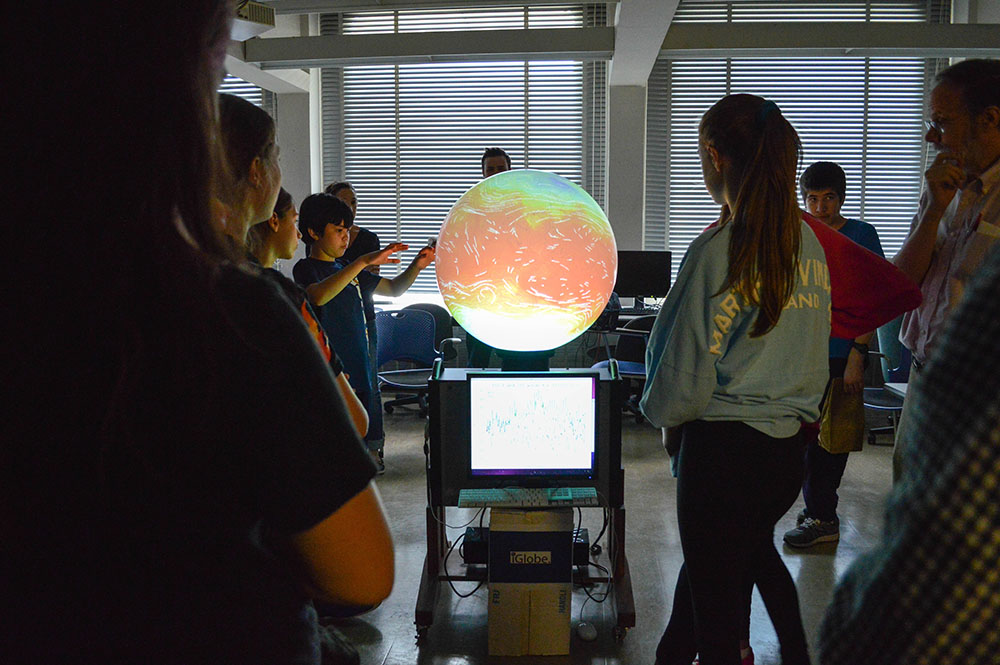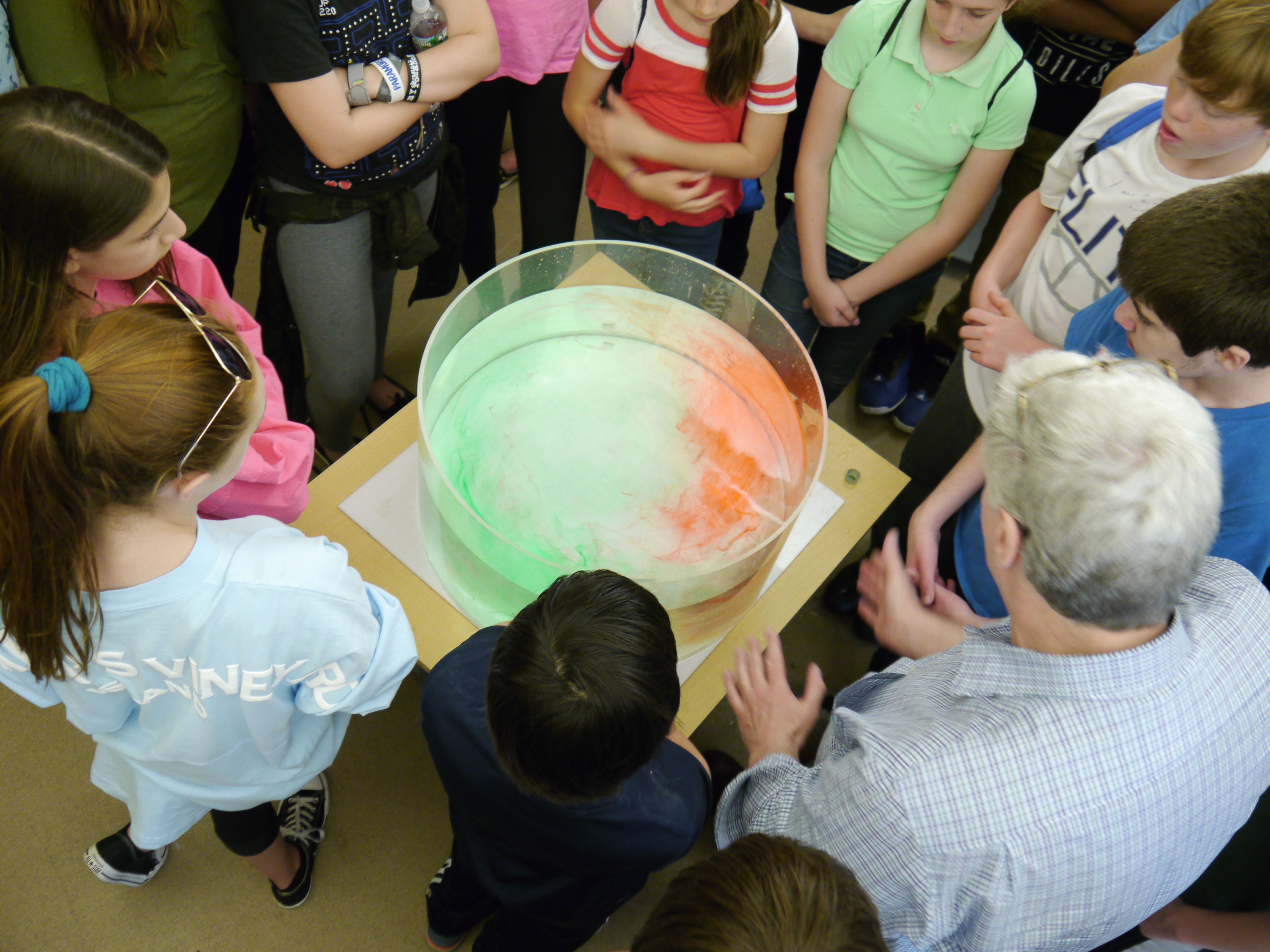PAOC Spotlights
Middle School Students Pay PAOC a Visit
A group of students from Weston Middle School recently visited EAPS to learn about the atmosphere, weather, and oceans.
***
Recent sunny days and warm temperatures signal the beginning of summer and the end of yet another school year. Before schools adjourn for the holiday, many take advantage of the nice weather and embark on field trips—one last hands-on learning opportunity for students. Last week, a group of sixth graders from Weston Middle School visited MIT’s Department of Earth, Atmospheric, and Planetary Sciences (EAPS), to learn about the atmosphere, weather, and oceans.
 First on the agenda was a visit to a classroom on the 16th floor of MIT’s tallest building, where EAPS Oceanographer Glenn Flierl and EAPS Meteorologist Lodovica Illari dazzled students with the iGlobe—a three-dimensional orb onto which over 250 movies of ocean, weather, and climate can be projected. Flierl and Illari displayed movies of cloud formations, atmospheric water vapor, the 2012 hurricane season known for severe storms such as hurricane sandy, and the spread of radioactive particles from the Fukushima nuclear disaster. The students were particularly interested in the radioactive particles, which looked like confetti swirling around the planet. One student asked if the different colored specs represented different elements. Illari said that the colors represented changing concentrations of the same element. Meanwhile, Flierl explained that the particles—initially concentrated over Japan—were swept up into the atmosphere and traveled around the globe with the weather, which took about 10 days.
First on the agenda was a visit to a classroom on the 16th floor of MIT’s tallest building, where EAPS Oceanographer Glenn Flierl and EAPS Meteorologist Lodovica Illari dazzled students with the iGlobe—a three-dimensional orb onto which over 250 movies of ocean, weather, and climate can be projected. Flierl and Illari displayed movies of cloud formations, atmospheric water vapor, the 2012 hurricane season known for severe storms such as hurricane sandy, and the spread of radioactive particles from the Fukushima nuclear disaster. The students were particularly interested in the radioactive particles, which looked like confetti swirling around the planet. One student asked if the different colored specs represented different elements. Illari said that the colors represented changing concentrations of the same element. Meanwhile, Flierl explained that the particles—initially concentrated over Japan—were swept up into the atmosphere and traveled around the globe with the weather, which took about 10 days.
Later, on the roof of the Green Building, Illari taught students how to use instruments that measure wind direction and speed. The breezy, partly cloudy weather made for perfect conditions. The students passed around spinning weathervanes, which showed the wind blew north. A second instrument, called an anemometer, recorded wind speeds of up to seven miles per hour. “Do you think the wind speed on the ground is the same as here on the roof?” Illari asked. The students answered no, but they didn’t know why. Illari explained that objects like buildings and trees act as barriers to the wind. Higher up in the atmosphere there are no barriers, so winds are stronger.
 The students ended their trip inside the fluid dynamics laboratory, where EAPS Oceanographer John Marshall demonstrated currents found in the ocean and atmosphere using rotating tanks of water and colored dye. First, the students gathered around a stationary tank and a few eager volunteers repeatedly dunked their hands into the water, agitating it. When Marshall added the dye, the red and green splotches slowly dispersed, eventually disappearing altogether. “But what happens if we do the same experiment in a tank of water that’s spinning?” Marshall rhetorically asked as he and the students gathered around another tank on a turntable. The rotation of the tank represents Earth’s rotation, he explained, and creates currents called eddies. Again, a few students agitated the water and Marshall added the dye. This time the eddies swept up the dye, creating colorful ribbon-like swirls. Marshall likened the swirls in the tank to Jupiter’s big red spot and phytoplankton blooms in the ocean.
The students ended their trip inside the fluid dynamics laboratory, where EAPS Oceanographer John Marshall demonstrated currents found in the ocean and atmosphere using rotating tanks of water and colored dye. First, the students gathered around a stationary tank and a few eager volunteers repeatedly dunked their hands into the water, agitating it. When Marshall added the dye, the red and green splotches slowly dispersed, eventually disappearing altogether. “But what happens if we do the same experiment in a tank of water that’s spinning?” Marshall rhetorically asked as he and the students gathered around another tank on a turntable. The rotation of the tank represents Earth’s rotation, he explained, and creates currents called eddies. Again, a few students agitated the water and Marshall added the dye. This time the eddies swept up the dye, creating colorful ribbon-like swirls. Marshall likened the swirls in the tank to Jupiter’s big red spot and phytoplankton blooms in the ocean.
And with that, the EAPS portion of the field trip came to an end. Everyone, including teachers, students, and MIT faculty, seemed to enjoy themselves.